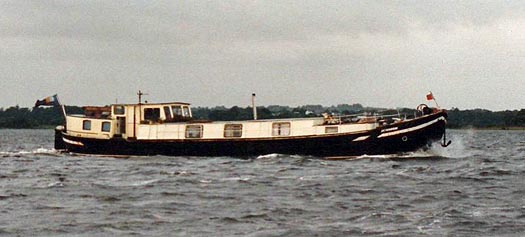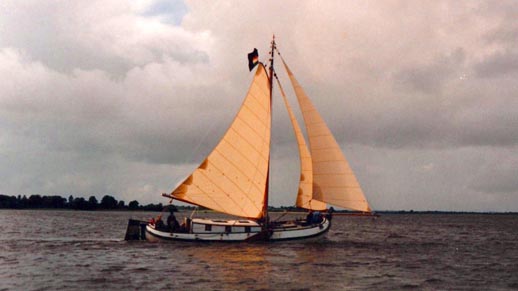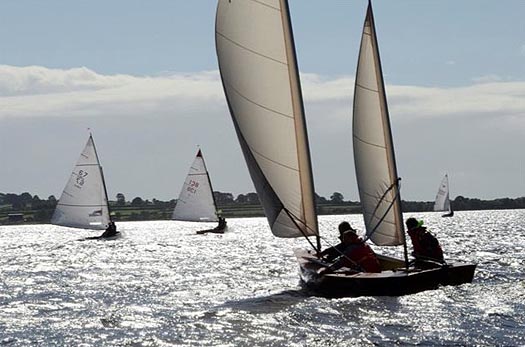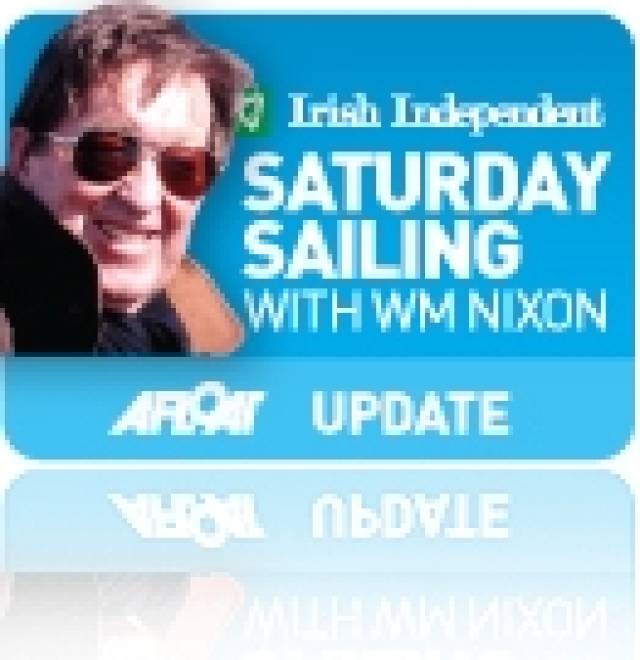#americascup – The America's Cup is a sacred monster, hellbent on devouring its own followers. That is part of its awful fascination. You play with fire if you get involved with this "greatest" of sailing's sporting challenges. Either you succeed in using it for your own purposes, or it uses you and dumps you afterwards. No-one, but no-one, goes through the experience unmarked.
Its history includes a litany of personal tragedies such as suicide, bankruptcy and jail. And major international diplomatic rows for good measure. Entire reputations are won and lost with it. Yet once again, here it is, 2013 and an America's Cup Year. Like it or lump it, this is the tops. The America's Cup is the peak of our sport. Alas.
We only have to look at the history of Irish involvement to get the flavour of it. First one into the fire in 1886 was William Henn, whose family owned property in County Clare and lived in Paradise House on the estuary of the Fergus River southwest of Ennis. Henn challenged with Galatea, a large (102ft) comfortable performance cruiser, designed by Beavor Webb who'd been born in Enniskillen.
Seagoing comfort was a good idea in those early days of challenging, as the defending Americans insisted the challenging yachts should sail on their own bottoms across the Atlantic, just as the America herself had sailed to Europe in 1851. But Galatea was outsailed in light winds for the Cup races. So the gallant Lieutenant Henn and his supportive wife and their ship's company (including Peggy the pet monkey) stayed in America and lived aboard the Galatea in the hope of stronger winds for another challenge the following spring. They lost those races as well, but their winter presence in America had fascinated the rapidly developing newspaper industry, and reinforced the tendency where the people involved, their private lives, and the source of their funding, is of as much public interest in the America's Cup as the yachts and sport itself.
It's said that the remains of Galatea can still be discerned in the Fergus Estuary – certainly Conor O'Brien, another Shannon Estuary sailor, mentioned her as being anchored off Paradise House. The house itself is now a derelict overgrown shell, and the Henn family is long gone from County Clare.
Thereafter, America's Cup challenges became much more professional and inevitably controversial, and none more so than with Lord Dunraven from the other side of the Shannon Estuary, at Adare in County Limerick. His first challenge in 1893 used the G L Watson-designed Valkyrie II (117ft), but as this was the first time Nathanael Herreshoff had designed the defender, the peformance stakes were much raised, and Valkrie II suffered three straight defeats.
But Dunraven had got a taste for it, and though enormously wealthy (an ancestor had married a Welsh heiress whose property included several fields, all of them coalfields), he got together a syndicate of wealthy people, mostly Irish landowners, to support him in challenging again in 1895 with the new Valkyrie III.
This time round, public interest reached an all-time high, and Dunraven protested that the presence of large spectator steamers had hampered his boat's performance. Things got really nasty, the problem was never really resolved, the lawyers were busy, Dunraven was turfed out of his membership of the New York Yacht Club (an unprecedented event), and it all ended in tears.
Down the years, Lord Dunraven is remembered only as the prickly little aristocrat who got into an international row as a consequence of the America's Cup. It's true, but it's unfair. He was a man of prodigious energy, something of an inventor, and an enlightened landowner and employer. Despite the unpleasantness in America, he was remarkably successful in political negotiation and working towards agreement, although he was never a fulltime politician.
In 1902 he chaired the conference in Ireland which resulted in the establishment of the Land Commission, and thereby ended the Land League wars. It was a pivotal achievement in Irish history.
The shape of modern Irish agricultural life and the type and size of farms we have to underpin our rural society today is in part due to the patience, diligence, skill and understanding of Windham Thomas Wyndham-Quin, fourth Earl of Dunraven. Yet all he is remembered for is his troubles with the America's Cup.
Those troubles in turn saw his syndicate members distance themselves. Only thanks to the new Martin Black book on G L Watson do we now know that people like the McCalmonts of Mount Juliet in Kilkenny were financial supporters of the Valkyrie III challenge. But by this time it was big business, and with the unpleasantness left by the Valkyrie III affair, the way was open for a new challenger to bring peace and sportsmanship to the fore.
It tells us much about the good sense of John Jameson, the most successful owner of large racing yachts in Ireland in the late 19th Century, that he turned down all blandishments to get involved in the America's Cup circus. But then came Thomas Lipton, "the man who invented himself". From humble origins in Monaghan, rising through shops in Glasgow which became an expanding international retail empire, he saw the America's Cup as an opportunity, an attractive sporting challenge in which he could gain favourable publicity for the Lipton brand on both sides of the Atlantic.
Though all seemed bonhomie and good sportsmanship, Lipton could be quite ruthless in putting his five campaigns together, even though, in the end, none was successful You needed a recognized yacht club through which to challenge, so having failed to join the Royal Yacht Squadron through being in trade and because of his humble origins, as a Monaghan man he turned to the Royal Ulster Yacht Club in Belfast, who elected him with acclaim. But until then, the RUYC had got by without a clubhouse, though they had a starting battery in Bangor. Lipton insisted he needed a club with a clubhouse, so 30 of the 130 total membership of the RUYC divvied up to build a complete new clubhouse in Bangor in jig time, and it was finished in April 1899.
With hindsight, we can see that for the RUYC, the America's Cup challenge was the cuckoo in the nest. Already, some of the keenest sailing members had moved away to join a new club further up the lough, which soon became the Royal North of Ireland YC at Cultra. Meanwhile, the energies of the best administrators back in RUYC were being taken up with Lipton's first three challenges – in 1899, 1901 and 1903. Other forms of sailing were very definitely second fiddle in RUYC. Yet we now know that Lipton was not in the least grateful. It is said that he was only once in the fine new clubhouse built at his behest, though doubtless they'd have seen more of him if he'd won and the RUYC was defending. But as for his loyalty to RUYC, it was very flexible – we now know that in 1904 he was preparing another challenge through his new VBFs, the Royal Irish Yacht Club in Dun Laoghaire.
That failed to go ahead only because the design rules for the challenge could not be agreed between Lipton and the New York YC, and for his remaining two challenges in 1914-19 (war intervened), and 1931, Lipton returned to RUYC. He never did win the cup, though Shamrock IV could well have done it had the series gone ahead as planned in 1914 before the outbreak of the Great War. But his genial sportsmanship, sometimes a skilled act, worked well to gain favourable publicity for his retail business interests.
Direct Irish interest therefore ended in 1931, though in 1983 Cork's finest, Harold Cudmore, played a key role in the historic wresting of the Cup from the Americans after they'd held it for 132 years. John Bertrand helming the 12 Metre Australia II had the slightly faster boat, but defender Dennis Conner with Liberty was the more skilled helmsman-tactician, and this was most evident at the starts. The Australians called for a lay day, as they were entitled to, and provided Cudmore with a 12 Metre to go out and put the Bertrand/Australia II combo through a gruelling day of start training off Newport. In the best of seven series, the Americans had already won the first two races, but now Australia II clawed her way back with Bertrand's improved confidence at the starts. It was then the Americans who called for a lay day, and in all the series ran for 14 tense days until, on Monday September 26th 1983, America lost the America's Cup by 4 races to 3 after a neck and neck final race.
Dennis Conner then won the trophy back in one of the finest America's Cup series of all, off Perth, Western Australia in 1987. Subsequently, the highest level of Irish interest came through Michael Fay's New Zealand challenges which were made by someone who was proud to proclaim his Irish lineage at every opportunity. But the America's Cup has been won and lost and won again and lost again, almost despite other events of global concern. Wars have been fought, empires have fallen, fortunes have been made and lost, great crimes have been committed, man has walked on the Moon, and new forms of sailing have come to the fore. Yet despite the world in general and the world of sailing in particular changing out of all recognition, some 162 years after a fine schooner won a race around the Isle of Wight, the America's Cup is more than ever the peak of sailing. It defines the lives of all those involved with it, and as summer draws on we will all look with increasing and sometimes horrified fascination towards San Francisco and an epic battle between incredible 72ft catamarans raced at unbelievable cost.
RIOT ON REE
We had The Raid up the Erne and down the Shannon last September. Now we have the RIOT round Lough Ree and down the Shannon to Lough Derg, set for the last week of June this year.
RIOT is Round Ireland On The Inside. The inside is Lough Ree, beside which you can find the pillar marking exact centre of Ireland. It was put up by some Victorian worthies in Westmeath who had little enough to do with their time except work out sums, and calculate through a weird formula the location of the exact centre of the Emerald Isle. Putting up a pillar made it official, and good luck to them for doing so. That said, it might be interesting to use today's computers to see just how accurate they were.
But there's no rush to do so, and there has been no rush in promoting the idea of the Round Ireland On The Inside Race either. Alan Algeo has had the idea for a very long time. I can remember it being discussed at length (and towards no immediate conclusion) when were cruising Lough Ree back in 1998 on his 85ft barge Linquenda, in company with David Beattie's 47ft Dutch Lemsteraak Schollevaer.
Things have changed, however. Alan Algeo has now got his hands clamped firmly around the levers of power. He is Commodore of Lough Ree Yacht Club (founded 1770), and having already served one dutiful and awfully well-behaved year, he has earned the right to implement some of his own notions. Then too, he was one of the most enthusiastic participants in The Raid, sailing the 17 mile length of Lough Ree in a Shannon One Design in a minute or two over two hours, which is cooking with gas for sure, and gives him some right to suggest how much others should be able to achieve in the course of a day's sail.
Other factors are involved. The mighty Linquenda will be celebrating her Centenary. More of a ship than a barge, she was built as a heve-barge (a single-masted sailing vessel) in 1913 at Westervoort in order to serve as a hagenaar, that is plying the route to The Hague. She will make a superb mother-ship and committee boat for the RIOT, but there'll be more centenaries than that to observe, as the Schollevaer is also going to be marking her hundred years.
She'll have more than that to celebrate, for in the big freeze of 2010, one of her hull inlets split through ice pressure, and owner David Bettie returned to his waterside house on Lough Ree to see his beloved boat's mighty mast sticking up out of the icefloes, but with precious little else still visible. The restoration is ongoing, but we're assured Schollevaer will be there in prime order to mark a hundred years and a re-birth.
Another celebrant will be Dan O'Connor's fine motor-cruiser Harklow, marking her Golden Jubilee, as she was built for Douglas Heard by Jack Tyrrell of Arklow in 1963 to succeed Douglas's original inland cruiser, the converted lifeboat Hark with which he was the last skipper to pass through the Royal Canal in 1954, when it's eventual re-opening in 2010 would have been dismissed as a crazy dream. You will have guessed that Hark was Heard's Ark abbreviated, while the Harklow name acknowledged the Tyrrell input into the new boat using ideas learned from the old.
So the hope is there'll be more than enough in the way of big boats with lids and beds to provide hospitality for those on little boats with neither. Thus the RIOT really can undertake a series of extended passage races which will take the fleet right round Lough Ree in considerable detail and to many venues. Numbers will then be augmented come the weekend, with boats joining for the annual two day Shannon One Design Long Distance Race from Lough Ree down to Lough Derg, with an overnight at Banagher.
The details are still being finalized, but basically the RIOT starts with an informal assembling at Lough Ree YC in Athlone on the evening of Sunday 23rd June, and there's racing every day from Monday 24th June onwards, finishing at various places on the lake in a continuum, and getting back to LRYC on Friday June 28th.
Next day they race the first half of the Long Distance to Banagher, then it all winds up on Sunday June 30th at Lough Derg. Judging by the eclectic entry for The Raid, the RIOT will be of interest to boats of many types, indeed the fact that much of its is happening in Lough Ree will mean that keelboats can also be realistically involved. Lough Ree YC website is www.lryc.ie.

Lough Ree YC Commodore Alan Algeo's ship-like 85ft barge Linquenda will be celebrating her Centenary during the RIOT on Lough Ree at the end of June Photo: W M Nixon

David Beattie's 47ft fully-rigged Lemsteraak Schollevaer has been restored, and will be sailing Lough Ree and the Shannon in June to celebrate her Centenary. Photo: W M Nixon

Two Shannon ODs and a ketch racing on Lough Ree in The Raid last September
BANKING ON AN ISLAND
Why on earth are people throwing up their hands in horror at the news that hundreds of thousands of tons of material extracted from tunneling in Dublin is going to be dumped about three miles out to sea just beyond the mouth of the bay? This isn't a problem. This is an opportunity.
It has long been obvious that the Leinster coast needs more islands. In watching Sean Cullen's fascinating presentation about the INFOMAR surveys in December at Poolbeg Y & BC, and in particular his computerized displays showing the details of Dublin Bay, it became immediately obvious that the Burford Bank is an island which is just waiting to happen.
Think of how much more interesting Dublin Bay would be with its own Sable Island stretching for a mile or two north-south out where the Burford is now awash, providing shelter and an anchorage and somewhere to see, and maybe even visit?
After all, it's not so long ago that the Bull Island simply didn't exist. Yet now, thanks to the limited technology of the 19th Century in building the North Bull Wall, there it is – the Bull Island is one of the most important, welcome and popular features of the entire bay.
So surely with 21st Century technology we can manage something, and further out in the bay at that. But before creating new islands, be mindful that Dublin Bay has lost at least one. There used to be a Clontarf Island, and you can still see the remains of a house that was reputedly on it when you turn right off the Alfie Byrne Road to go along the front of Clontarf towards Howth. It looks like the ribs of an old shipwreck, or even the framework of a wooden pier, but it's apparently the lower skeleton of the house still there, but the island long gone.
Clontarf Island was noted as a healthy place to be when Dublin was afflicted by plague, so in the 1830s a wooden summer house was built on it by a Dublin publican called Christopher Cromwell. He is said to have been a descendant of Oliver Cromwell, and no, I'm not making this up, but somebody else may well have done so once upon a time. Anyway, on the 9th October 1844 Christopher and his ten year old son William were overnighting out on their island, and a mighty storm came up and swept everything away, sadly including father and son – their bodies were found along the shore, while most of the house was splintered along the then-new Great Northern Railway embankment, which ran along the beach but is now well inland.
It may well be that the reclaiming of land along the East Wall road with the consequent narrowing of the Tolka Estuary meant the island was also being eroded by the river as well as the sea, but it is a fact that an island which was shown clearly on all maps until 1844 – and whose ownership was at times disputed – had simply disappeared after the massive Autumn storm of 1844.
So we should bear this in mind when planning to build Burford Island. But with the ready availability of the basic material thanks to all this stuff which is going to be tunneled soon in Dublin, some rapid planning is necessary before it is all wasted by being dribbled into the sea somewhere off the Baily.
The great yacht designer John B Kearney, in his day job as the de facto Harbour Engineer to Dublin Port, led the way in experimenting with screw-in piling to support the North Bull Lighthouse at the entrance to Dublin Port. It would be a fine memorial to him if we could use the Kearney technique to drive a couple of hundred giant corkscrews into the Burford Bank in order to hold the tunnel waste in place, and thereby allow a sandbank to build up just like the Bull Island above high water level.
With the creation and expansion of the Bull Island almost within living memory, we have a very accurate record of the sort of plants which thrive in island-building in Dublin Bay, and a repeat of this out at the Burford would be a wonderful exercise which would provide employment for many specialists, and also of course be a tourist attraction.
In no time at all we would have the new island well covered with tough marram grass. Soon after that we could experiment with easy-growing cordylines, as most people think they're palm trees, and who are we to teach them otherwise? For what we want is an island in place in jig time, and if it looks like vaguely like an island of the South Pacific, so much the better. In no time at all there'd be a golf course on it, and then a casino, and a hundred years hence people will want to keep it exactly as it has become, because by then it will be an important part of our heritage.
THE AMERICANS DO IT BIGGER
They don't necessarily do it better, but there's no doubt Americans do it bigger. Latest area of interest for them is in being top of the size pile is in semi-tame wild cetaceans.
For years now, ever since 1984 or thereabouts, Ireland has been something of a world leader in this very specialised field with Fungie of Dingle. He (or she) is undoubtedly a wild creature, the essence of freedom, yet Fungie chooses to have such a close relationship with people, and particularly the boatmen of Dingle, that he/she can tell if one of the dolphin-watching boat drivers is in a gloomy mood.
So it really is something very special, particularly as Fungie is now quite some size. But Americans do it bigger. Much bigger. The word is there's a semi-tame fin whale in California which is showing unusual interest in boats and the people in them. He has stayed for some days now at Dana Point in southern Los Angeles, and has shown no sign of wanting to move on as all the rest of his group have done.
While he's not putting on displays like Fungie does, perhaps it's as well. The new Dana Point resident – they already call him Farley – is pushing towards 40 feet in length, and therefore chimes in at around a hundred tons. But he behaves in the playful manner of a much smaller creature, and his apparently genuine friendliness and fascination with boats and people is completely new to California's experienced whale watchers. There's an unusually high level of tasty krill in the area at the moment, so maybe the good food is putting Farley in a specially friendly mood, as he needs between three and four tons of krill a day. Whatever, he's definitely a bigger attraction than most of the movie stars in nearby Hollywood.
































































